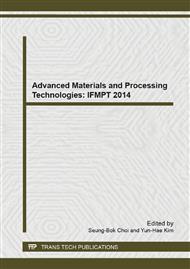p.167
p.172
p.177
p.181
p.187
p.191
p.199
p.203
p.209
Investigation on the Structure and Luminescence Performance of Tb-Doped ZnO Nanocrystals Prepared by Direct Precipitation
Abstract:
Terbium-doped zinc oxide (ZnO:Tb) nanocrystals were prepared by a direct reactive precipitation progress. Incorporation of terbium in ZnO nanocrystals had been proved by X-ray diffraction (XRD), transmission electron microscope (TEM) and fluorescence spectrophotometer. XRD investigations confirm that the samples of ZnO:Tb nanocrystals with a hexagonal wurtzite crystalline structure don’t exist the diffraction peaks of the compounds of terbium. The results of TEM analysis show that the as-prepared samples with an average particle size less than 20 nm were obtained. The photoluminescence (PL) spectra suggest that there is no luminescence peaks corresponding to the terbium compounds in ZnO:Tb samples; the green emission intensity gradually decreases with the increase of the Tb-doped concentration in ZnO matrix. A core-shell model of rare earth (RE) passivated ZnO is proposed, which the passivation layer existing on the ZnO surface, can generate a barrier to impede the formation of oxygen vacancy, corresponding to the green emission.
Info:
Periodical:
Pages:
187-190
Citation:
Online since:
February 2014
Authors:
Price:
Сopyright:
© 2014 Trans Tech Publications Ltd. All Rights Reserved
Share:
Citation:


